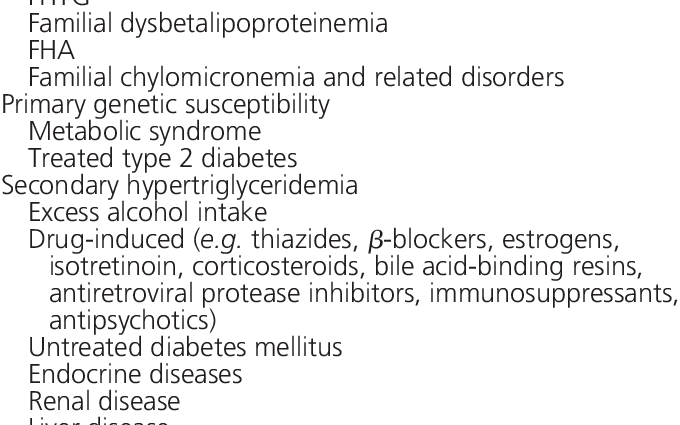Contents
- Hypertriglyceridemia: causes, symptoms and treatments
- What is hypertriglyceridemia?
- What are the different types of hypertriglyceridemia?
- What are the different causes of hypertriglyceridemia?
- Who is affected by hypertriglyceridemia?
- What are the consequences of hypertriglyceridemia?
- What are the symptoms of hypertriglyceridemia?
- Are there any risk factors?
- How to prevent hypertriglyceridemia?
- How to detect hypertriglyceridemia?
- What is the treatment for hypertriglyceridemia?
Hypertriglyceridemia: causes, symptoms and treatments
Hypertriglyceridemia is characterized by a too high triglyceride levels in the blood. Although they are essential for the proper functioning of the body, triglycerides are lipids whose excess can have harmful consequences on health.
What is hypertriglyceridemia?
Hypertriglyceridemia corresponds to a excess triglycerides within the organization. Triglycerides are lipids that allow the storage of fatty acids in adipose tissue. Depending on the body’s needs, triglycerides can be hydrolyzed to allow the release of fatty acids which are then used as an energy source by many organs. However, although they are necessary for the body, these lipids can be found in excess and cause complications.
In adults, we speak of hypertriglyceridemia when a lipid test reveals a blood triglyceride levels greater than 1,5 g / L, i.e. 1,7 mmol / L. This reference value may nevertheless vary according to the techniques for analyzing triglycerides and various parameters such as sex and age.
What are the different types of hypertriglyceridemia?
Depending on the severity of the excess triglycerides, it can be defined as:
- minor hypertriglyceridemia when the triglyceridemia is less than 2 g / L;
- moderate hypertriglyceridemia when the triglyceridemia is between 2 and 5 g / L;
- major hypertriglyceridemia when triglyceridemia is greater than 5 g / L.
It is possible to distinguish two other types of excess triglycerides:
- isolated hypertriglyceridemia, or pure, when the lipid balance does not reveal any other dyslipidemia, qualitative or quantitative anomaly of one or more lipids;
- mixed hypertriglyceridemia when the excess of triglycerides is associated with other dyslipidemias such as hypercholesterolemia, excess cholesterol in the blood.
Hypertriglyceridemias can also be classified according to their causes. They can be presented as:
- primary forms, or primitive, when they are due to hereditary genetic abnormalities;
- secondary forms when they do not have a hereditary genetic origin.
What are the different causes of hypertriglyceridemia?
High triglyceridemia can have many causes such as:
- an inherited genetic defect ;
- bad eating habits with for example an excessive consumption of fats, sugars and alcohol;
- metabolic disorders including diabetes, overweight and obesity;
- taking certain medications such as corticosteroids, antipsychotics or even antiretrovirals.
Who is affected by hypertriglyceridemia?
Excess triglycerides in the blood can be measured at any age. Hypertriglyceridemia can be diagnosed in adults as well as in children.
The most frequent hypertriglyceridemia are the secondary forms which are not of hereditary genetic origin. Genetic predispositions to dyslipidemia are rarer.
What are the consequences of hypertriglyceridemia?
Like any nutrient, triglycerides can become harmful when they are present in excess in the body. The severity of the consequences nevertheless depends on the origin and the course of the hypertriglyceridemia.
When associated with hypercholesterolemia, hypertriglyceridemia is associated with increased risk of cardiovascular disease. If the triglyceride level is greater than 5 g / L, hypertriglyceridemia is said to be major and represents a significant risk of pancréatite aiguë (inflammation of the pancreas). In the absence of adequate treatment, the triglyceride level may continue to rise and reach 10 g / L. This critical threshold constitutes a medical emergency.
What are the symptoms of hypertriglyceridemia?
Hypertriglyceridemia is often asymptomatic. It is difficult to perceive. Its diagnosis requires a blood test.
However, in the most serious cases, hypertriglyceridemia can manifest itself by several symptoms including:
- abdominal pain;
- a deterioration of the general condition;
- rash xanthomatosis, characterized by the appearance of yellowish skin lesions.
Are there any risk factors?
Several risk factors have been identified by researchers. Among these factors, we find for example:
- overweight;
- bad eating habits;
- excessive alcohol consumption;
- smoking;
- physical inactivity ;
- some diseases ;
- taking certain medications;
- the aging of the body.
How to prevent hypertriglyceridemia?
It is possible to prevent an increase in triglyceridemia by limiting certain risk factors. For this, it is advisable to adopt several preventive measures:
- adopt a healthy and balanced diet;
- engage in regular physical activity;
- maintain a healthy weight, close to the normal BMI;
- not to smoke, or to quit smoking;
- consume alcohol in moderation.
How to detect hypertriglyceridemia?
Hypertriglyceridemia is identified during a lipid assessment. This blood test measures different lipid levels including the level of triglycerides (triglyceridemia).
What is the treatment for hypertriglyceridemia?
The treatment of hypertriglyceridemia depends on its course, its severity and the results of the lipid profile.
To reduce too high a triglyceridemia, it is often advisable to adopt a healthy lifestyle with a balanced diet and the practice of regular physical activity.
Depending on the type of hypertriglyceridemia, several treatments may also be prescribed. Taking fibrates, statins or omega 3 fatty acids can for example be recommended.










